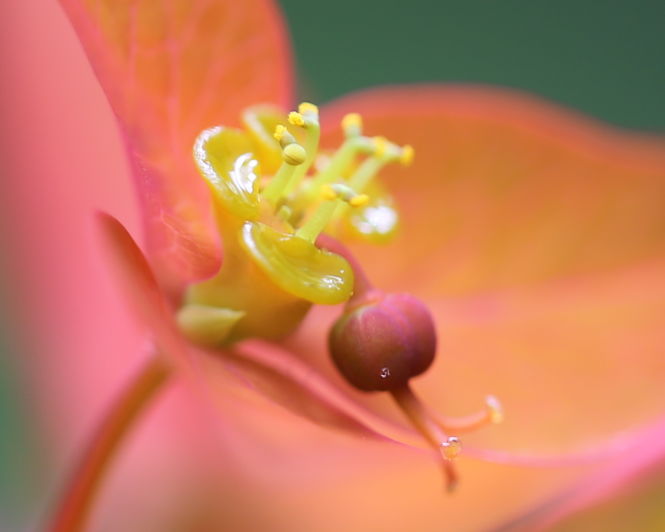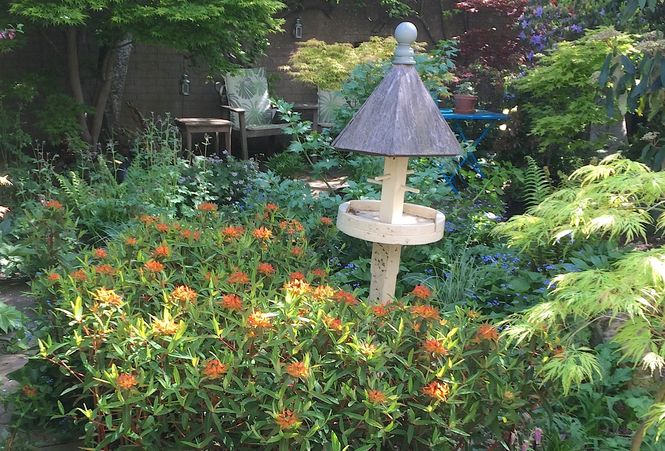Notes from the Chairman’s Garden: Euphorbia griffithii ‘Fireglow’
Having a city garden and a strong desire to create a design that delivers the feel of a cool woodland glade to be enjoyed in the heat of the summer is a challenge. One in which every plant must earn its keep and justify the space it takes up, each choice making a strong contribution to the display during and after flowering if possible, the aim being to create a living stage, an immersive ‘theatre of plants’ filled with performers to be viewed from the dining room window daily, no matter what the weather. Although in some gardens Euphorbia griffithii ‘Fireglow’ can be a bit of a thug, hence it is often maligned for its bullish behaviour! I personally have a soft spot for its joyful brightly coloured some would say bold and brassy personality; to me it fits the spirit of spring in the city so long as the clump is not allowed to become too large.

Originally native to Bhutan, Tibet and S.W. China the species was first recorded as being grown in the UK in 1949. The generic name Euphorbia celebrates Euphorbus, Physician to King Juba II of Mauritania [30BC - 23AD]; the specific name griffithi is after William Griffith [1810-45] a botanist and surgeon who worked for the East India Company in India and Afghanistan.
Despite some 6000 extant species having been identified in the plant family Euphorbiaceae today fossil evidence remains very limited worldwide. However, the existing fossil pollen records discovered in London Clay and from Australia indicate that it was present at opposite ends of the globe during the Paleocene 56.0 - 66.0 Ma. Other fossils from New Zealand are much younger having been dated at 23 Ma.; at present the main diversification of species is thought to have occurred during the Eocene between 33.9 - 50 Ma. The much larger Plant Order Malpighiales within which Euphorbiaceae is classified holds around 36 plant families and around 16,000 species and is considered to be a little older having arisen around 101.0 - 114.0 Ma.
Leaving the ancient past of this brassy chap behind and returning to the present day I want to mention a few other favourites of mine from within the genus that deserve a place in your garden. Firstly the must have and strikingly different Euphorbia characias subsp. wulfenii, with its large erect columns of lime green flowers that provide a luxuriant eye catching, yet cooling element to the overall design of any planting scheme. Next, also for a well drained sunny spot Euphorbia myrsinites with its distinct blue and sliver foliage and bright yellow flowers and then for more shady situations I do like the lime green flowered Euphorbia amygdaloides var robbiae, which also delights and thrives in poor soils.
Euphorbias are insect pollinated mainly by flies, however ants and beetles also occasionally visit them. They also have a highly specialised inflorescence called a cyathium made up of many cup shaped structures or involucre in this case highlighted further by the brightly coloured red papery bracts, which are actually adapted leaves. Look closely and you will see the single female flower with a turbinate ovary at the centre as well as the much smaller male flower complete with a ring of tiny anthers around the edge, some of which are open and crowned with golden pollen. The cyathium have glands, which produce large quantities of nectar, and it is this, which attracts the tiny insects (mainly flies) to feed on the plant. In return, they transfer the tiny pollen grains from the anthers to the style at the top of each ovary as they flit from flower to flower and plant to plant.
Euphorbia griffithi and the various cultivars that have arisen from it such as ‘Fireglow’ and ‘Great Dixter’ [a strong orange coloured form] grow best in full sun but they will also tolerate partial shade. It is not overly fussy about soil type but does enjoy moist well-drained conditions. Here in my smaller garden I tend to keep the conditions a little on the dry to keep it in check. In addition depending on growth and if I have time and I remember, some years I have even experimented by cutting the whole plant back after flowering and giving it a good soak. After which it produces a fine flush of fresh foliage for the remainder of the season; but I suspect if you did this every year it would weaken the clump considerably. It is generally resistant to insect pests and disease but in some seasons I have seen a touch of mildew, which I generally prune out with no issue to get it under control quickly. Being vigorous and I suspect quite distasteful it is also fairly tolerant of deer and rabbit damage. For propagation, division in early spring is best as the ground warms up and the shoots just begin to emerge; but remember to wear gloves to keep the sap off your skin, as the roots will bleed a little when cut.

Where space allows it looks really eye-catching when planted on a large scale in combination with yellow azaleas and blue bells. In the small garden it can look great with small early flowering bulbs including iris, crocus and chinodoxa. I have also planted Lilium henryi at the back of the clump between rhizomes and the shorter growing Lilium regale to the front so that they can emerge and flower above the foliage later in the season providing much needed interest. Dahlia merkii and Dahlia coccinea have played their part in that role quite successfully in the past as well.
Although Euphorbia or Spurge does not have any meaning within the Victorian Language of Flowers, in some western cultures it has since the Middle Ages been associated with purity and the ability to provide protection from evil, especially the actions of witches. Whilst other members of the genus have cosmetic, culinary, industrial and medicinal uses, some even being used in the treatment of cancers, this particular species is purely ornamental; some florists like to cut and treat the flowers stems for use in arrangements but remember as noted earlier that the milky sap can be an irritant upon contact with skin.
All the species and cultivars that I have noted plus others are widely available commercially from garden centres and mail order nurseries; some have even been known to make an appearance on sales tables at some of our garden openings.
So there you have it a ‘brazen charmer’ for the garden, as well as a few more genteel relatives with cooler stylish flowers and in some cases statuesque form. So the next time you pass them by do look closer at the flower heads and the wonder they contain taking a moment to think about their evolutionary journey and just how amazing that relationship with tiny insects really is never mind how it began! Never forget your garden, every garden is filled with hidden mystery and a ‘Sense of Wonder’ if you look close, observe and learn. Enjoy!
David R Mitchell
5th May 2020


 Find a Garden
Find a Garden

 What's New
What's New

 Our Impact
Our Impact

 Join
Join


